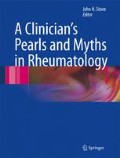Abstract
Gout is caused by the crystal deposition of monosodium urate in and around joint tissues. The first joint affected in the majority of cases is the first metatarsophalangeal joint, a condition known as podagra. Acute gout is characterized by the rapid development of warmth, swelling, erythema, and pain in the affected joint. The natural history of gout is to worsen with time, progressing through the stages of asymptomatic hyperuri-cemia and acute intermittent gouty attacks to tophaceous gout. The time period between the first development of acute intermittent gouty attacks and the appearance of chronic tophaceous gout is approximately a decade in most cases. The development of tophaceous deposits of monosodium urate is a function of the degree and duration of hyperuricemia. However, most people with hyperuricemia never develop clinical gout.
Access this chapter
Tax calculation will be finalised at checkout
Purchases are for personal use only
References
Annemans L, Spaepen E, Gaskin M, Bonnemaire M, Malier V, Gilbert T, Nuki G. Gout in the UK and Germany: prevalence, comorbidities and management in general practice 2000–2005. Ann Rheum Dis. 2008;67:960–6
Becker MA, Schumacher HR Jr, Wortmann RL, MacDonald PA, Eustace D, Palo WA, Streit J, Joseph-Ridge N. Febuxostat compared with allopurinol in patients with hyperuricemia and gout. N Engl J Med. 2005;353:2450–61
Ben-Chetrit E, Levy M. Colchicine: 1998 update. Semin Arthritis Rheum. 1998;28(1):48–59
Bomalaski JS, Lluberas GR, Schumacher HR Jr. Monosodium urate crystals in the knee joints of patients with asymptomatic nontopha-ceous gout. Arthritis Rheum. 1986;29(12):1480–4
Centers for Disease Control and Prevention, national Center for Health Statistics. Vital and health statistics: current estimates from the national Health Interview Survey, 1996. Series 10, No. 200. Atlanta: Department of Health and Human Services (US). Available at http://www.cdc.gov/nchs/data/series/sr_10/sr10_200.pdf
Chen KR, Carlson JA. Clinical approach to cutaneous vasculitis. Am J Clin Dermatol. 2008;9(2):71–92
Choi MH, MacKenzie JD, Dalinka MK. Imaging features of crystal-induced arthropathy. Rheum Dis Clin N Am. 2006;32:427–46
Cronstein BN, Terkeltaub R. The inflammatory process of gout and its treatment. Arthritis Res Ther. 2006;8(Suppl 1):S3
Edwards NL. The role of hyperuricemia and gout in kidney and cardiovascular disease. Cleve Clin J Med. 2008;75(Suppl 5):S13–6
Famaey JP. Colchicine in therapy. State of the art and new perspectives for an old drug. Clin Exp Rheum. 1988;6(3):305–17
Faraj AA, Omonbude OD, Godwin P. Gram staining in the diagnosis of acute septic arthritis. Acta orthop Belg. 2002;68(4):388–91
Hippocrates. The genuine works of Hippocrates, volumes 1 and 2. Translated and edited by Adams F. New York: Wood; 1886
Molad Y, Cronstein BN, Malawista SE. Colchicine. In: Smyth CJ, Holers VM, editors. Gout, hyperuricemia, and other crystal-associated arthropathies. New York: Marcel Dekker; 1998. p. 193–204
Pascual E, Batlle-Gualda E, Martinez A, Rosas J, Vela P. Synovial fluid analysis for diagnosis of intercritical gout. Ann Intern Med. 1999;131:756–9
Shah K, Spear J, Nathanson LA, McCauley J, Edlow JA. J Emerg Med. 2007;32(1):23–26
Urano W, Yamanaka H, Tsutani H, Nakajima H, Matsuda Y, Taniguchi A, Hara M, Kamatani N. The inflammatory process in the mechanism of decreased serum uric acid concentrations during acute gouty arthritis. J Rheumatol. 2002;29:1950–3
Author information
Authors and Affiliations
Editor information
Editors and Affiliations
Rights and permissions
Copyright information
© 2009 Springer Science+Business Media B.V.
About this chapter
Cite this chapter
Cronstein, B.N., Pillinger, M.H. (2009). The Clinical Features of Gout. In: Stone, J.H. (eds) A Clinician's Pearls and Myths in Rheumatology. Springer, London. https://doi.org/10.1007/978-1-84800-934-9_34
Download citation
DOI: https://doi.org/10.1007/978-1-84800-934-9_34
Publisher Name: Springer, London
Print ISBN: 978-1-84800-933-2
Online ISBN: 978-1-84800-934-9
eBook Packages: MedicineMedicine (R0)

